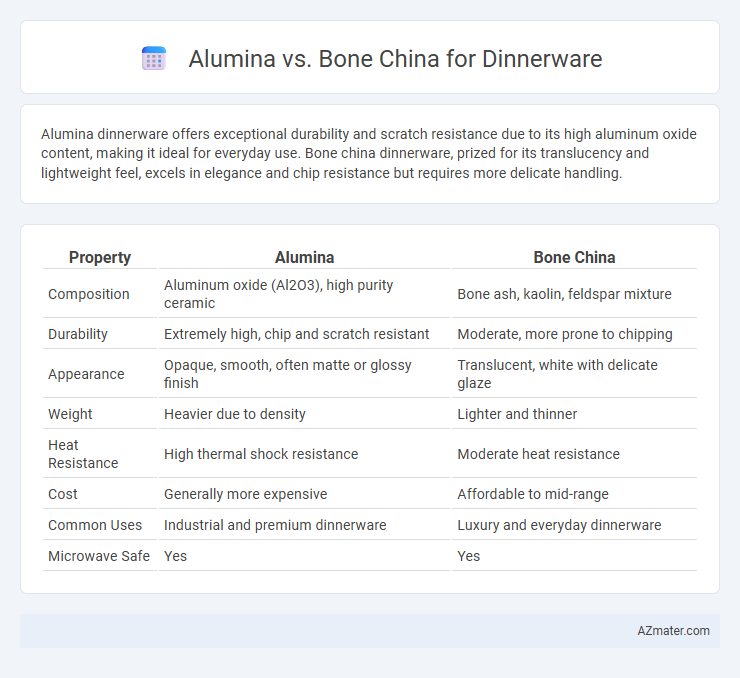Alumina dinnerware offers exceptional durability and scratch resistance due to its high aluminum oxide content, making it ideal for everyday use. Bone china dinnerware, prized for its translucency and lightweight feel, excels in elegance and chip resistance but requires more delicate handling.
Table of Comparison
| Property | Alumina | Bone China |
|---|---|---|
| Composition | Aluminum oxide (Al2O3), high purity ceramic | Bone ash, kaolin, feldspar mixture |
| Durability | Extremely high, chip and scratch resistant | Moderate, more prone to chipping |
| Appearance | Opaque, smooth, often matte or glossy finish | Translucent, white with delicate glaze |
| Weight | Heavier due to density | Lighter and thinner |
| Heat Resistance | High thermal shock resistance | Moderate heat resistance |
| Cost | Generally more expensive | Affordable to mid-range |
| Common Uses | Industrial and premium dinnerware | Luxury and everyday dinnerware |
| Microwave Safe | Yes | Yes |
Introduction: Alumina vs Bone China for Dinnerware
Alumina dinnerware features high durability and chip resistance, making it ideal for everyday use and commercial settings. Bone china offers a delicate, translucent appearance with exceptional whiteness, prized for formal dining and elegant table settings. Choosing between alumina and bone china depends on the balance between durability and aesthetic appeal desired for the dining experience.
Material Composition and Manufacturing Process
Alumina dinnerware is made primarily from high-purity aluminum oxide, providing exceptional strength and chip resistance through a sintering process at ultra-high temperatures, resulting in a dense, non-porous material. Bone china contains a mixture of bone ash, feldspathic material, and kaolin clay, fired at lower temperatures, which yields a translucent, lightweight, and strong porcelain known for its whiteness and delicate appearance. The manufacturing of alumina focuses on advanced ceramic engineering for durability, while bone china production relies on traditional porcelain techniques that emphasize aesthetic refinement and translucency.
Durability and Strength Comparison
Alumina dinnerware offers exceptional durability and strength due to its high alumina content, making it highly resistant to chipping and cracking compared to bone china. Bone china, while elegant and lightweight, has a lower density and is more prone to damage from impact or thermal shock. For long-lasting dinnerware, alumina provides superior mechanical strength and resilience, ideal for heavy daily use.
Weight and Handling Experience
Alumina dinnerware is renowned for its lightweight nature, making it easier to handle and less fatiguing during use compared to bone china, which tends to be heavier due to its higher density and composition. The sturdiness of alumina provides enhanced durability while maintaining a sleek, thin profile ideal for frequent handling in busy kitchens. Bone china offers a delicate, refined feel but requires more careful handling to avoid chipping, contrasting with alumina's robust resilience and practical usability.
Aesthetic Appeal: Color and Translucency
Alumina dinnerware showcases vibrant colors with a smooth, often opaque finish that resists fading, making it ideal for bold table settings. Bone china offers exceptional translucency and a delicate, luminous white hue that enhances its elegant, refined aesthetic appeal. The subtle glow and softness of bone china create an exquisite visual contrast to alumina's robust and solid appearance.
Heat Retention and Microwave Safety
Alumina dinnerware offers superior heat retention due to its high thermal conductivity, keeping food warm longer compared to bone china. Bone china, known for its delicate and porous structure, generally retains less heat but is lighter and more elegant in appearance. Both materials are microwave safe; however, alumina's durability ensures better resistance to thermal shock and microwave heating compared to bone china, which may be more prone to cracking under rapid temperature changes.
Scratch and Chip Resistance
Alumina dinnerware offers superior scratch and chip resistance compared to bone china due to its denser and more durable ceramic composition. Its high alumina content enhances hardness, making it less prone to surface damage from utensils and accidental drops. Bone china, while elegant and lightweight, tends to be more delicate and susceptible to chipping and scratching during regular use.
Cost and Affordability Factors
Alumina dinnerware offers a cost-effective alternative to traditional Bone china, with prices typically 30-50% lower due to simpler manufacturing processes and durable raw materials. Bone china, crafted from refined bone ash and porcelain clay, commands higher prices for its translucent quality and elegance, often making it less affordable for everyday use. For budget-conscious consumers, Alumina provides excellent durability and aesthetic appeal without the premium cost associated with Bone china.
Environmental Impact and Sustainability
Alumina dinnerware boasts higher durability and resistance to chipping, extending product lifespan and reducing waste compared to bone china, which is more fragile and prone to breakage. Alumina production consumes less natural resources and energy, as it does not require animal-derived bone ash, making it a more sustainable choice from an ethical and ecological standpoint. Bone china's reliance on bone ash raises ethical concerns and contributes to higher environmental footprints, whereas alumina's fully inorganic composition supports lower carbon emissions and recyclability.
Best Uses: Choosing the Right Dinnerware for Your Needs
Alumina dinnerware offers exceptional durability and chip resistance, making it ideal for everyday use in busy households and commercial settings. Bone china, known for its lightweight, translucent quality and elegant appearance, is best suited for formal occasions and special events. Selecting between alumina and bone china depends on balancing practicality with aesthetic preferences for everyday durability or refined presentation.

Infographic: Alumina vs Bone china for Dinnerware
 azmater.com
azmater.com